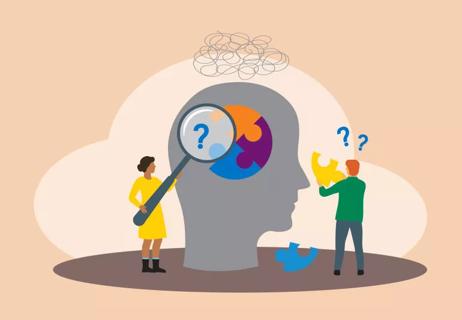Fishing for compliments, provoking conflict and pouring on the melodrama are all ways of expressing an unmet need

We’ve all done things we regret to get noticed. Laughed a little too loud for a little too long. Rolled our school-issued gym shorts all the way up. Made an ill-advised joke in a meeting. You think back on these moments every once in a while and cringe. But hey, the occasional social misstep is all part of being human! We want to be liked.
Advertisement
Cleveland Clinic is a non-profit academic medical center. Advertising on our site helps support our mission. We do not endorse non-Cleveland Clinic products or services. Policy
But for some people, attention-seeking behavior isn’t the exception. It’s the norm. And in those cases, it’s a sign of an underlying problem. Psychologist Susan Albers, PsyD, explains what attention-seeking behavior is, what fuels it and what you can do about it.
The fifth edition of the Diagnostic and Statistical Manual of Mental Disorders (DSM-5) defines attention-seeking as “engaging in behavior designed to attract notice and to make oneself the focus of others’ attention and admiration.” Attention-seeking can be a conscious or unconscious act, or a combination of the two. Approval is the goal, Dr. Albers explains. But that doesn’t mean attention-seeking is always positive. Some people “act out” in negative ways to get the recognition they want.
Attention-seeking can be a symptom of an underlying psychiatric disorder. But it can also be a personality trait that’s unrelated to mental illness. More on that in a bit.
“To put it in the language young people are using these days, a person with attention-seeking tendencies seems very ‘extra,’” Dr. Albers illustrates. Not down with the kid lingo? That’s OK. These examples of attention-seeking behavior will help:
Advertisement
Attention-seeking doesn’t sound like most people’s idea of a good time. But as Dr. Albers clarifies, it’s important not to demonize the person doing these things.
“Sometimes, attention-seeking behavior can be exhausting, annoying or frustrating. That’s part of the reason why the term has a negative connotation. But we all have to take a step back and ask ourselves, ‘Why is this person attention seeking?’ It’s often because they’re trying to get their needs met in some way. And when you think of it in those terms, it can help you be more empathetic.”
Leaving our biases behind makes it easier to grasp the root causes of attention-seeking.
Easier, but not easy.
There are a lot of possible reasons a person may crave the spotlight. And they aren’t all unhealthy.
“Attention-seeking can be part of somebody’s personality,” Dr. Albers explains, “or it can be pathological. The behavior is linked with both histrionic personality disorder and narcissistic personality disorder.”
So, how can you tell the difference between having a flair for the dramatic and living with mental illness?
“If being dramatic is part of your personality, you’ll know — at least most of the time — when to draw boundaries,” she continues. “You can turn it on and off or give attention to other people in a balanced way.” Attention-seeking is unhealthy when your relationships with other people always look one-sided, when the focus never shifts to someone else.
There’s another way to tell if the attention-seeking behavior you’re observing is a personal quirk or a personality disorder: The result.
“Ask yourself if being the center of attention fills you up. If it helps your self-esteem in any way,” Dr. Albers advises. People who have a big personality often find performing for others gratifying. Those who seek attention out of desperation are less likely to feel that way.
“When attention seeking is pathological, it’s persistent, regardless of the consequences,” she adds. “And it can have some very negative consequences. For example, being provocative or flirty — if you’re crossing lines or violating other people’s boundaries — can be harmful in the long run.”
Whether it’s personality or pathology, or something in between, here are some common reasons people engage in attention-seeking behavior:
To a certain extent, we’re all a product of our upbringing.
“Some children learn that they’ll only get their needs met if they make a spectacle of themselves or throw a temper tantrum,” Dr. Albers explains. “If it’s reinforced, that behavior can continue into adulthood.”
There’s a couple of ways trauma can cause attention-seeking behavior:
Advertisement
Sometimes, behavior that looks like attention-seeking is actually a side effect of emotional regulation problems, according to Dr. Albers.
Autistic people, for example, may struggle to identify and express emotions — their own and others’. Difficulty communicating causes frustration that can lead to outbursts, meltdowns and mood swings. Those behaviors might look like attention-seeking to an outsider.
Many neurodivergent people rely on mimicry and masking to interact with others. But their efforts may be misinterpreted. In some cases, trying to “act neurotypical” ends up reading like attention-seeking.
Remember when we said that attention-seeking often expresses an unmet need? Connection with others is a universal human need. And not everyone has the social skills, self-confidence or emotional intelligence to easily forge those bonds.
A person whose behavior is a bit “extra” may simply be trying, as best they can, to demonstrate that they’re valid — and worth getting to know.
We’ve all been on the receiving end of attention-seeking behavior before. How do you usually respond? And has it worked?
“Particularly with children and people who get overdramatic, our tendency is to ignore the behavior,” Dr. Albers shares.
Advertisement
Unfortunately, that can actually make things worse. Instead, she recommends drilling down on what that person needs. Then, offer them a replacement behavior that will actually meet those needs.
“A teacher instructing a child to raise their hand instead of fussing is a common example of a replacement behavior,” Dr. Albers explains. “And you can apply the same principle in all of your relationships.”
In order to do that, you need to have an honest, compassionate conversation. That’s not something you can do spur of the moment. It’s better to set a time for a private discussion like this. When the time comes, be sure to:
Advertisement
But what if you’re the one displaying attention-seeking behavior? What if it’s your friend, coworker or partner who’s calling you out or setting new boundaries?
The steps actually look pretty similar.
“It’s important to read the room,” Dr. Albers advises. “Instead of being defensive, take the time to understand both how your actions are impacting other people and the feedback that they’re giving you about it. Then, take a close look at what purpose your behavior is serving.”
Figuring out the root cause of your own behavior can be tough. Dr. Albers recommends working with a therapist to do this work. A therapist can help you better understand when it’s healthy to get attention and when it isn’t. They can teach you healthy ways to meet your needs, as well as coping skills to get you through moments that trigger attention-seeking.
If you’ve ever heard somebody describe a person self-harming, committing acts of violence or attempting suicide as “doing it for attention,” you aren’t alone. It’s an unfortunate belief that many people hold. But it’s never OK to trivialize violence of any kind.
Remember: Attention-seeking happens when a person’s needs are going unmet. If someone is thinking about hurting themselves or others, what they need in that moment is help. And they need that help immediately.
If you believe somebody is in imminent danger of hurting themselves or others, call emergency services.
Learn more about our editorial process.
Advertisement

By setting boundaries around how much you give, you can save your time and resources while also being a good person

Certain B vitamins, omega-3 fatty acids and a healthy diet can serve as complementary treatments for schizophrenia

Following your treatment plan, finding a community, staying active and maintaining a healthy diet can help manage this psychiatric condition

Whether it’s playing hooky or faking cancer, malingering behavior is always motivated by personal gain

Causes range from psychological conditions like PTSD to physical conditions like fibromyalgia

Always putting others’ happiness before your own can build resentment over time

Emotional changes, isolation and unusual behavior could signal the onset of the condition

People with schizoaffective disorder have additional mood symptoms

The best parenting style balances enforcing rules and showing plenty of love

Tips include cutting back on sugar, focusing on exercise and managing stress

It can be harder to let go when you’ve invested time, energy and emotions — but it might be the healthier choice long term